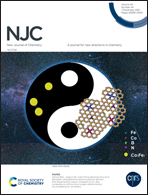β-Cyclodextrin-capped ZnO-doped carbon dot as an advanced fluorescent probe for selective detection of dopamine†
Abstract
Selective and sensitive detection of dopamine (DA) in the presence of other interfering biomolecules is very challenging in biomedical analysis. Here, we have reported the one-pot synthesis strategy of water-soluble β-cyclodextrin-capped ZnO-doped carbon dot (ZnO-CD) via a simple hydrothermal treatment of β-cyclodextrin (β-CD) and zinc acetate. The as-synthesized ZnO-CDs have a very small size, ∼2–3 nm, and are used as an efficient sensing probe. The aqueous solution of ZnO-CDs exhibits excitation-dependent emission properties. They exhibit the maximum intensity in the blue region of the visible spectrum under excitation at ∼360 nm with the emission maximum at ∼443 nm. The blue emissive ZnO-CDs have shown a high quantum yield (∼18%), good colloidal stability, and photostability under UV light exposure. ZnO-CDs have been used for selective sensing of DA in the presence of other interfering biomolecules with a detection limit of ∼285 nM. Interestingly, DA sensing has also been performed in a mixture of interfering biomolecules. To explore their practical significance as a sensing probe, this fluorescent probe has been used to determine the DA content in spiked blood samples with remarkable accuracy, selectivity, and sensitivity. Based on our results, we propose that selective sensing of DA occurs via the host–guest interaction of DA with β-CD on the ZnO-CD surface, followed by electron transfer through the oxidized form of DA under excitation. Thus, the fluorescence of ZnO-CDs is “turned-off” selectively in the presence of DA.



 Please wait while we load your content...
Please wait while we load your content...